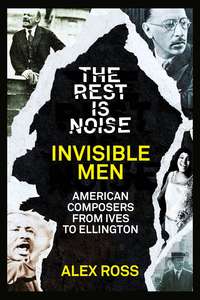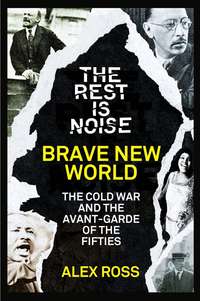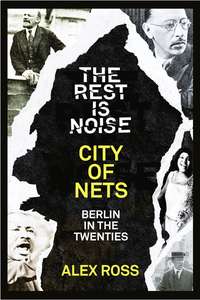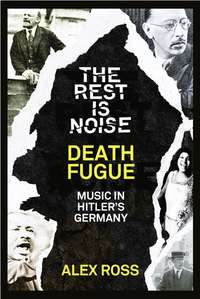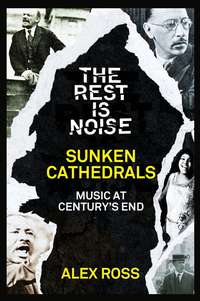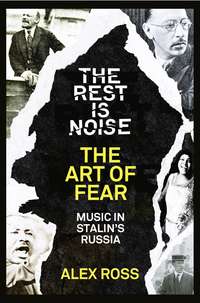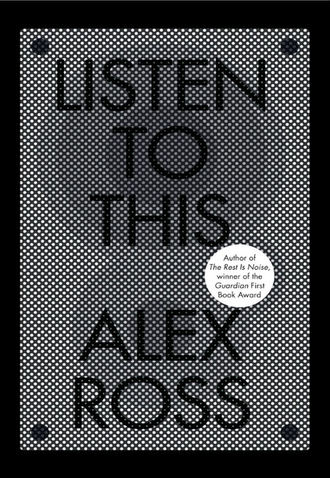
Полная версия
Listen to This
One feature common to many early blues, whether commercial or rural, is the old downward chromatic slide. It runs in an almost subliminal way through the opening sequence of “St. Louis Blues,” and makes an unmistakable appearance in Bessie Smith’s 1925 recording of the song, where the young Louis Armstrong traces rapierlike solos on his trumpet. In Mamie Smith’s “Crazy Blues,” it takes on burlesque exuberance, merging with the sassy glissando of the slide trombone.
In the late twenties and thirties, recording technology captured the voices of numerous authentic practitioners of the Delta blues: Charley Patton, Willie Brown, Son House, Skip James, Robert Johnson, and others. These singers made a living variously as field hands, laborers, drifters, and bootleggers, playing in their spare time. All over their records you hear a rapid articulation of the descending chromatic figure—think of the “Crucifixus” bass line sped up and stripped down. When Willie Brown plays it on “Future Blues,” the strings snap violently in emphasis:
Can’t tell my future, I can’t tell my past
Lord, it seems like every minute sure gon’ be my last.
Skip James, the canniest musician among Delta blues singers, uses the chromatic riff for ironic effect in “I’m So Glad”; it’s an ostensibly uplifting number with a gospel tinge, but the continual chromatic undertow undercuts the singer’s claim to be “tired of weeping, tired of moaning, tired of groaning for you.” Chromatic lines snake through James’s “Devil Got My Woman,” a beautifully baleful ode to love gone wrong: “I’d rather be the devil than be that woman[’s] man …” Robert Johnson, rumored to have sold his soul to the devil for the sake of his art, leaned heavily on the chromatic slide in such numbers as “Cross Road Blues,” “Me and the Devil Blues,” and “Walkin’ Blues.”
The origins of the riff are obscure. It seems to have deep roots in black music, reaching back through ragtime to the sketchily documented repertories of nineteenth-century African-American song. It might even be related to slithery chromatic lines that have been recorded in chants of the Ewe and Yoruba peoples, in West Africa. Although it holds to the classic devil’s-staircase shape, it has little apparent connection to the ostinato laments of previous eras: it’s a decorative element, not a bass line. And it gives off a different vibe, in keeping with the emotional complexity of blues form. A blues is sensual, knowing, tough; it’s full of resilience, even as it heeds the power of fate. The gesture of lament annuls itself and engenders its opposite. This is the subtext of Duke Ellington’s pathbreaking 1935 piece Reminiscing in Tempo, a thirteen-minute jazz fantasia propelled by a short chromatic ostinato. It was written in the wake of the death of the composer’s mother, but it keeps sorrow at bay, ending in a jaunty, urbane mood. The trudging ostinato becomes a walking, dancing bass.
Blues chromaticism entered the American mainstream through the hot jazz of the Roaring Twenties. It was also a favorite tool in the workshops of Tin Pan Alley: Gershwin loved to introduce half-step motion into the inner voices of songs like “Someone to Watch Over Me.” A hint of the descending chromatic bass shadows the opening of Richard Rodgers’s “My Funny Valentine.” Of course, Tin Pan Alley writers, many of them from Russian-Jewish backgrounds, had multiple sources for these tricks of the trade; they drew liberally on late-Romantic classical music and also on Yiddish song. One way or another, the sighing chromatic line became so widespread as a sign of worldly-wise sophistication that it turned into a journeyman cliché. Sometimes, though, it came bearing a more urgent message. When Frank Sinatra began making downcast concept albums in the later 1950s—In the Wee Small Hours, Only the Lonely, No One Cares, and other studies in Cold War melancholia—he seemed to require morose chromatic lines to set the tone. A lamenting pizzicato bass prowls through Sinatra’s “Angel Eyes,” whose Scotch-soaked emotional state goes from the vengeful to the suicidal (“Excuse me while I disappear”).
Sinatra’s nocturnal ballads of the fifties forecast a weird and wonderful twist of musical history: the return, circa 1965, of the chromatic basso lamento, in strict, almost neo-Baroque guise. Why it came back is difficult to explain. For one thing, the American folk-music revival of the fifties gave new life to ancient ballad forms, which depended on strophic repetition. Also, Baroque music was much in vogue in the later fifties, with I Musici’s recording of Vivaldi’s Four Seasons and Glenn Gould’s account of the chaconnelike Goldberg Variations selling in mass quantities. And perhaps Brazilian bossa nova played an assisting role; as Peter Williams points out, in his wide-ranging survey The Chromatic Fourth, liquid chromatic lines course through Antônio Carlos Jobim’s “Corcovado,” also known as “Quiet Nights of Quiet Stars.”
Whatever the reason, by the mid-sixties the lamento bass was again the rage. You hear it in “Chim Chim Cher-ee,” the waltzing chimney-sweep song in Richard and Robert Sherman’s movie musical Mary Poppins. You hear it also in “Michelle,” on the Beatles’ Rubber Soul, and in various later Beatles songs. It sounds seven times in Bob Dylan’s psychedelic manifesto “Ballad of a Thin Man,” setting up the refrain “Something is happening here / But you don’t know what it is / Do you, Mr. Jones?” (The song’s dramatis personae, consisting of one-eyed midgets, circus geeks, and sword swallowers in high heels, vaguely resembles the guest list for the wedding of Almadán, as described in Juan Arañés’s “Un sarao de la chacona.”) The rock scholar Walter Everett has catalogued dozens of chromatic basses in sixties and seventies pop: a peculiar playlist could be assembled from the likes of “How Could I Be Such a Fool?” “Can’t Take My Eyes off You,” “My Way,” “Hooked on a Feeling,” “Time in a Bottle,” and the Eagles’ “Hotel California.” As Everett notes, the last song is fittingly set in a decadent Spanish-mission town, by the side of a desert highway.
It fell to Led Zeppelin, the behemoth hard-rock band of the seventies, to perfect the rock Baroque. Dylan and the Beatles may have won the plaudits of the intellectuals, but Led Zeppelin launched a no less ambitious raid on music history, commandeering rock, folk music, Delta blues, Indian and other non-Western music, and smatterings of classical tradition. “Babe I’m Gonna Leave You” and “Stairway to Heaven” both take off from meticulous finger-picking exercises for semi-classical guitar, with descending chromatic lines interwoven; washes of Bachian organ playing give a churchy aura to “Your Time Is Gonna Come” and “Since I’ve Been Loving You.” Several of the band’s weightiest creations rest on artfully repeating bass lines: “Kashmir” is built on a riff that climbs step by chromatic step.
Led Zeppelin’s early magnum opus was “Dazed and Confused,” a tormented love song that Jimmy Page, the band’s fleet-fingered, mildly satanic guitarist, first started playing when he was in the Yardbirds. Page borrowed many elements of the piece from a New York singer-songwriter named Jake Holmes, who included a track with the same name on his 1967 album “The Above Ground Sound” of Jake Holmes. Holmes’s song is anchored in consecutive chromatic descents; they were the work of an itinerant bass guitarist named Rick Randle, whom Holmes later described as “absolutely stone, raving mad,” and who was last reported living in Utah with a witch.

In the Led Zeppelin version, which appeared on the band’s debut album of 1969, John Paul Jones gave the bass line a forbidding, organlike sound—the Delta blues riff monumentalized. In recordings from the band’s stadium tours of the early seventies, where the song stretches on for half an hour or more, the bass motto undergoes ostentatious transformations, sometimes shimmering on Page’s bowed guitar, sometimes shrieking in the high falsetto zone of Robert Plant’s voice. For long stretches, the bass falls silent while singer and guitarist call out to each other, like wanderers lost in a desolate landscape. Finally, in a climactic passage, the theme is thundered out on guitar and bass in tandem, saturating the musical space.
When the chacona first surfaced, at the end of the sixteenth century, it promised an upending of the social order, a liberation of the body. The same outlaw spirit animates modern rock and pop: the swirl of a repeating bass line allows a crowd of dancing fans to forget, for a little while, the linear routines of daily life. When Frescobaldi and Bach recast the dance as a stern, inward-turned form, bending it toward lament, they hinted at a different sort of freedom, that of the individual defining himself in opposition to the mass. “Dazed and Confused,” in its inner sections, implies a similar quest for self: the raw drive of rock and roll gives way to spacey variations. It’s a big, brash rock anthem at heart, but, just as the dance abides in Bach’s chaconne, the lament lingers in the rock arena. Above all, the song demonstrates how the same deep musical structures keep materializing across the centuries. If a time machine were to bring together some late-sixteenth-century Spanish musicians, a continuo section led by Bach, and players from Ellington’s 1940 band, and if John Paul Jones stepped in with the bass line of “Dazed and Confused,” they might, after a minute or two of confusion, find common ground. The dance of the chacona is wider than the sea.
3 INFERNAL MACHINES HOW RECORDINGS CHANGED MUSIC
More than a century ago, the composer and bandleader John Philip Sousa warned that technology would destroy music. Testifying before the United States Congress in 1906, he said, “These talking machines are going to ruin the artistic development of music in this country. When I was a boy … in front of every house in the summer evenings you would find young people together singing the songs of the day or the old songs. Today you hear these infernal machines going night and day. We will not have a vocal cord left.” Sousa expanded on the theme in subsequent articles and interviews. “The time is coming when no one will be ready to submit himself to the ennobling discipline of learning music,” he declared. “Everyone will have their ready made or ready pirated music in their cupboards.” Something is irretrievably lost when we are no longer in the presence of bodies making music, Sousa also said. “The nightingale’s song is delightful because the nightingale herself gives it forth.”
Before you dismiss Sousa as a curmudgeon, you might consider how drastically music has changed in the past hundred years. It has achieved onrushing omnipresence in our world: millions of hours of its history are available on disc; rivers of digital melody flow on the Internet; MP3 players with forty thousand songs can be tucked in a back pocket or a purse. Yet, for most of us, music is no longer something we do ourselves, or even watch other people do in front of us. It has become a radically virtual medium, an art without a face. When we walk around the city on an ordinary day, our ears will register music at almost every turn—bass lines pumping from passing cars, bits of hip-hop seeping out of the headphones of teenagers on the subway, a lawyer’s cell phone tweeting Beethoven’s “Ode to Joy”—but almost none of it will be the immediate result of physical work by human hands or voices. Fewer and fewer people know how to play instruments or read music. In the future, Sousa’s ghost might say, reproduction will displace production. Zombified listeners will shuffle through the archives of the past, and new music will consist of rearrangements of the old.
Ever since Edison invented the phonograph cylinder, in 1877, people have been assessing what the medium of recording has done for and to the art of music. Inevitably, the conversation has veered toward rhetorical extremes. Sousa was a pioneering spokesman for the party of doom, which was later filled out by various reactionaries, contrarians, Luddites, and post-Marxist theorists. In the opposite corner are the utopians, who argue that technology has not imprisoned music but liberated it, bringing the art of the elite to the masses and the art of the margins to the center. Before Edison came along, the utopians say, Beethoven’s symphonies could be heard only in select concert halls. Now recordings carry the man from Bonn to the corners of the earth, summoning the throng hailed in the “Ode to Joy”: “Be embraced, millions!” Glenn Gould, after renouncing live performance in 1964, predicted that within a century the public concert would disappear into the electronic ether, with a largely beneficial effect on musical culture.
Having discovered much of my favorite music through LPs and CDs, I am not about to join the lamenting party. Modern urban environments are often so soulless or ugly that I’m grateful for the humanizing touch of electronic sound. But neither can I accept Gould’s slashing futurism. I want to be aware of technology’s effects, positive and negative. I want a pragmatic theory that mediates between live performance and reproduction, without either apocalyptic screeching or corporate hype. Fortunately, scholars and critics have been methodically exploring this terrain for many decades, trying to figure out exactly what happens when we listen to music with no musicians in the room. They have reached no unshakable conclusions, but they give us most of the conceptual tools we need in order to listen with the alertness—and the ambivalence—that this magical medium demands.
The principal irony of the history of recording is that Edison did not make the phonograph with music in mind. Rather, he conceived of his cylinder as a business gadget, one that would supersede the costly, imperfect practice of stenography and have the added virtue of preserving in perpetuity the voices of the deceased. In an 1878 essay titled “The Phonograph and Its Future,” Edison or his ghostwriter proclaimed that his invention would “annihilate time and space, and bottle up for posterity the mere utterance of man.” “Annihilation” is an interestingly ambiguous figure of speech. Recording opened lines of communication between far-flung worlds, but it also placed older art and folk traditions in danger of extinction. With American popular culture as its house god, it brought about a global homogenization of taste, the effects of which are still spreading.
Although Edison mentioned the idea of recording music in his 1878 article, he had no inkling of a music industry. He pictured the phonograph as a tool for teaching singing and as a natural extension of domestic music-making: “A friend may in a morning-call sing us a song which shall delight an evening company.” By the 1890s, however, alert entrepreneurs had installed phonographs in penny arcades, allowing customers to listen to favorite songs over ear tubes. In 1888, Emile Berliner introduced the flat disc, a less cumbersome storage device, and envisioned with it the entire modern music business—mass distribution, recording stars, royalties, and the rest. In 1902, the first great star was born: the tenor Enrico Caruso, whose voice remains one of the most transfixing phenomena in the history of the medium. The ping in Caruso’s tone, that golden bark, made the man himself seem viscerally present, proving Edison’s theory of the annihilation of space and time. Not so lucky was Johannes Brahms, who, in 1889, attempted to record his First Hungarian Dance. The master seems to be sending us a garbled message from a spacecraft disintegrating near Pluto.
Whenever a new gadget comes along, salespeople inevitably point out that an older gadget has been rendered obsolete. The automobile pushed aside the railroad; the computer replaced the typewriter. Sousa feared that the phonograph would supplant live music. His fears were excessive but not irrational. The Victor Talking Machine Company, which the engineer Eldridge Johnson founded in 1901, marketed its machines not just as vessels for music but as instruments in themselves. In a way, Victor was taking direct aim at the piano, which, around the turn of the century, dominated domestic musical life, from the salon to the tavern. The top-selling Victrola of 1906, a massive object standing four feet tall and weighing 137 pounds, was encased in “piano-finished” mahogany, if anyone was missing the point. Ads showed families clustered about their phonographs, no piano in sight. Edison, whose cylinders soon began to lag behind flat discs in popularity, was so determined to demonstrate the verisimilitude of his machines that he held a nationwide series of Tone Tests, during which halls were plunged into darkness and audiences were supposedly unable to tell the difference between Anna Case singing live and one of her records.
Each subsequent leap in audio technology—microphones, magnetic tape, long-playing records, stereo sound, transistors, digital sound, the compact disc, and the MP3—has elicited the same kind of over-the-top reaction. The latest device inspires heady confusion between reality and reproduction, while yesterday’s wonder machine is exposed as inadequate, even primitive. When, in 1931, the composer and critic Deems Taylor heard a pioneering example of stereophonic recording, he commented, “The difference between what we usually hear and what I heard was, roughly, the difference between looking at a photograph of somebody and looking at the person himself.” Twenty years later, Howard Taubman wrote of a long-playing record on the Mercury label: “The orchestra’s tone is so lifelike that one feels one is listening to the living presence.” (Mercury promptly adopted “Living Presence” as its slogan.) A high-fidelity ad of the 1950s offered users “the finest seat in the house”—an experience not simply equal to the concert hall but superior to it, cleansed of the inconvenience of “audience distraction.” A television commercial of the seventies, starring Ella Fitzgerald, famously asked, “Is it live or is it Memorex?” Compact discs promised “perfect sound forever.”
Just as inevitably, audiophile happy-talk leads to a backlash among listeners who doubt the rhetoric of fidelity and perfection. Dissenters complain that the latest device is actually inferior to the old—artificial, inauthentic, soulless. Greg Milner has documented this never-ending back-and-forth in his book Perfecting Sound Forever, a smartly skeptical account of the ideology of audio progress. Some enthusiasts of the Edison cylinder felt that no other machine gave such a faithful sensation of the warmth of the human voice. When electrical recording came in, a few stalwarts detected nothing but fakery in the use of microphones to amplify soft sounds and invent a sonic perspective that does not exist for human ears. “I wonder if pure tone will disappear from the earth sometimes,” a British critic wrote in 1928.
Magnetic tape led to the most crucial shift in the relationship between recordings and musical reality. German engineers perfected the magnetic tape recorder, or Magnetophon, during the Second World War. Late one night, an audio expert turned serviceman named Jack Mullin was monitoring German radio when he noticed that an overnight orchestral broadcast was astonishingly clear: it sounded “live,” yet not even at Hitler’s whim could the orchestra have been playing in the middle of the night. After the war was over, Mullin tracked down a Magnetophon and brought it to America. He demonstrated it to Bing Crosby, who used it to tape his broadcasts in advance. Crosby was a pioneer of perhaps the most famous of all technological effects, the croon. Magnetic tape meant that Bing could practically whisper into the microphone and still be heard across America; a marked drop-off in surface noise meant that vocal murmurs could register as readily as Louis Armstrong’s pealing trumpet.
The magnetic process also allowed performers to invent their own reality in the studio. Errors could be corrected by splicing together bits of different takes. In the sixties, the Beatles and the Beach Boys, following in the wake of electronic compositions by Cage and Stockhausen, constructed intricate studio soundscapes that could never be replicated onstage; even Glenn Gould would have had trouble executing the mechanically accelerated keyboard solo in “In My Life.” The great rock debate about authenticity began. Were the Beatles pushing the art forward by reinventing it in the studio? Or were they losing touch with the rugged intelligence of folk, blues, and rock traditions? Bob Dylan stood at a craggy opposite extreme, turning out records in a few days’ time and avoiding any vocal overdubs until the seventies. The Dylan scholar Clinton Heylin points out that while the Beatles spent 129 days crafting Sgt. Pepper, Dylan needed only 90 days to make his first fifteen records. Yet frills-free, “lo-fi” recording has no special claim on musical truth; indeed, it easily becomes another effect, the effect of no effect. Today’s neoclassical rock bands pay good money to sound old.
The advent of digital recording was, for many skeptics, the ultimate outrage. The old machines vibrated in sympathy with their subjects: the hills and valleys on a cylinder or a flat disc followed the contours of the music. Digital technology literally chopped the incoming vibrations into bits—strings of 0’s and 1’s that were encoded onto a compact disc and then reconstituted on a CD player. Traditionalists felt that the end product was a kind of android music. Neil Young, the raw-voiced Canadian singer-songwriter, was especially withering: “Listening to a CD is like looking at the world through a screen window.” Step by step, recordings have become an ever more fictional world, even as they become ever more “real.” The final frontier—for the moment—has been reached with Auto-Tune, Pro Tools, and other forms of digital software, which can readjust out-of-tune playing and generate entire orchestras from nowhere. At the touch of a key, a tone-deaf starlet becomes dulcet and a college rock band turns Wagnerian.
Yet some audio equivalent of the law of conservation of energy means that these incessant crises have a way of balancing themselves out. Fakers, hucksters, and mediocrities prosper in every age; artists of genius manage to survive, or, at least, to fail memorably. Technology has certainly advanced the careers of nonentities, but it has also lent a hand to those who lacked a foothold in the system. Nowhere is this more evident than in the story of African-American music. Almost from the start, recording permitted black musicians on the margins of the culture—notably, the blues singers of the Mississippi Delta—to speak out with nothing more than a voice and a guitar. Many of these artists were robbed blind by corporate manipulators, but their music got through. Recordings gave Armstrong, Ellington, Chuck Berry, and James Brown the chance to occupy a global platform that Sousa’s idyllic old America, racist to the core, would have denied them. The fact that their records played a crucial role in the advancement of African-American civil rights puts in proper perspective the debate about whether or not technology has been “good” for music.
Hip-hop, the dominant turn-of-the-century pop form, gives the most electrifying demonstration of technology’s empowering effect. As Jeff Chang recounts, in his book Can’t Stop Won’t Stop: A History of the Hip-Hop Generation, the genre rose up from desperately impoverished high-rise ghettos, where families couldn’t afford to buy instruments for their kids and even the most rudimentary music-making seemed out of reach. But music was made all the same: the phonograph itself became an instrument. In the South Bronx in the 1970s, DJs like Kool Herc, Afrika Bambaataa, and Grandmaster Flash used turntables to create a hurtling collage of effects—loops, breaks, beats, scratches. Later, studio-bound DJs and producers used digital sampling to assemble some of the most densely packed sonic assemblages in musical history: Eric B. and Rakim’s Paid in Full, Public Enemy’s Fear of a Black Planet, Dr. Dre’s The Chronic.




